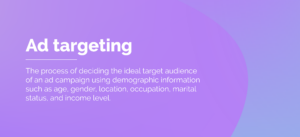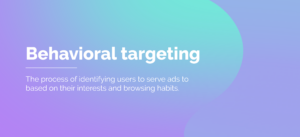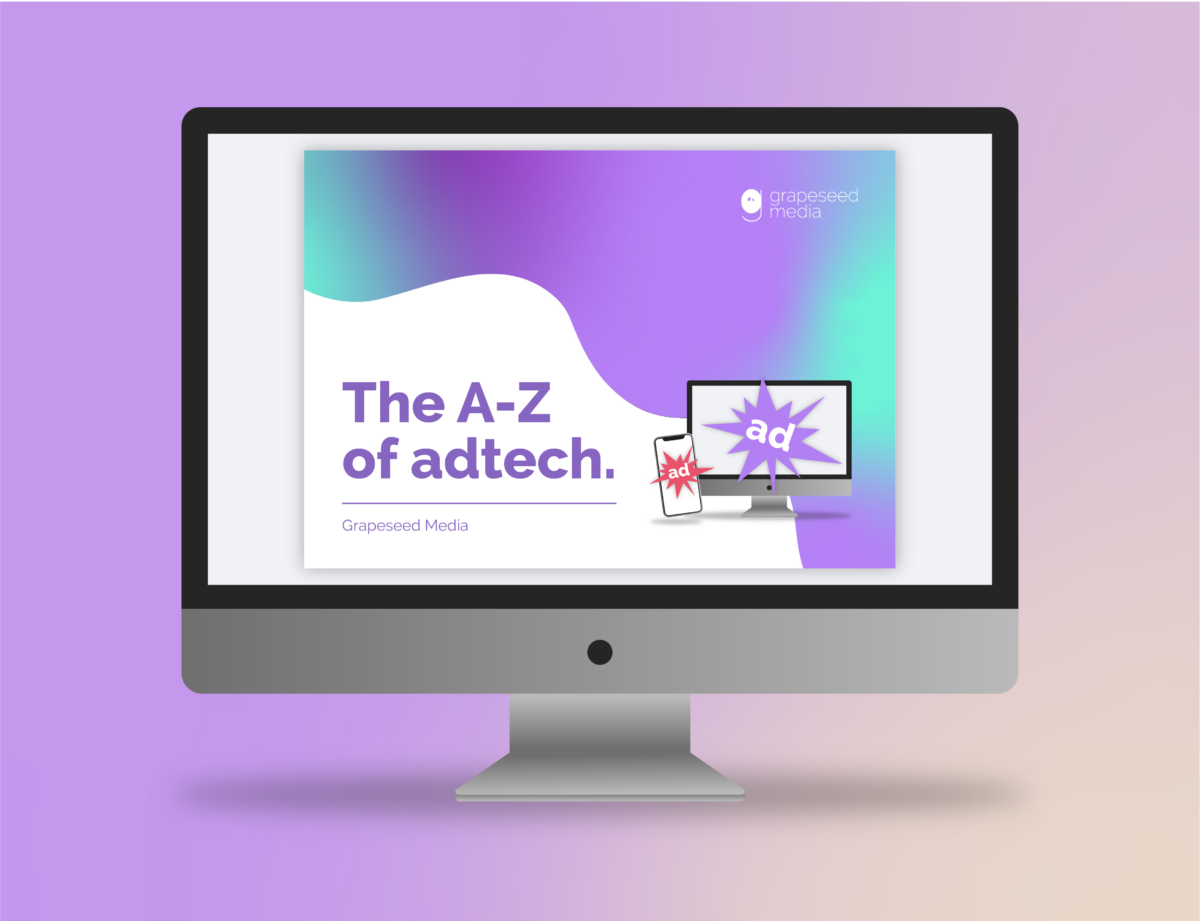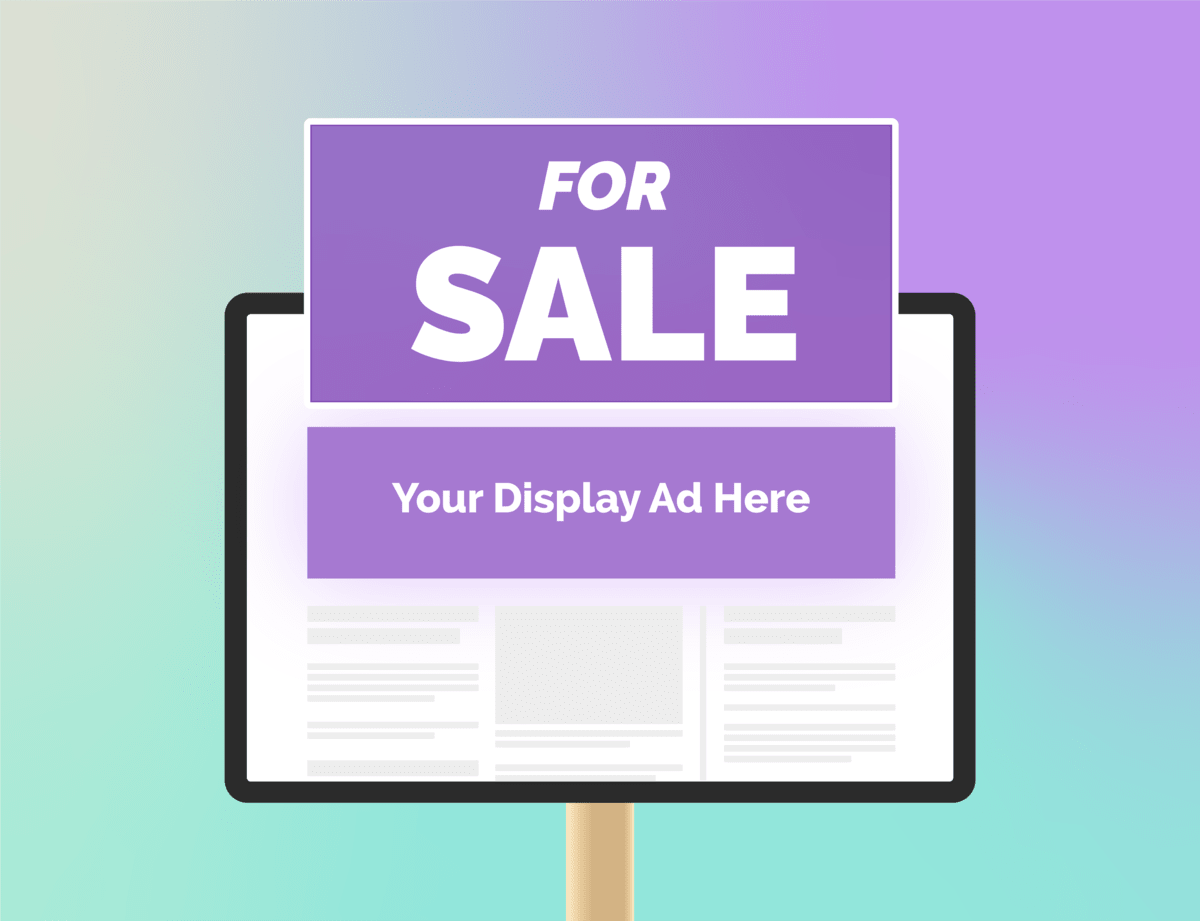When I first transitioned into the world of digital marketing, the sheer number of new terms was initially daunting. I had heard of a cookie before, but what was the difference between a DMP and a DSP? Or a CPI and a CPM?
Adtech — or advertising technology — refers to the technology, software, tools, and platforms advertisers and publishers use to run, monitor, manage, and optimize digital ad campaigns.
Due to the complex nature of digital advertising and the nonlinear evolution of the technology, adtech has developed a dictionary of terms, jargon, buzzwords, and acronyms that can sound like complete gibberish to the uninitiated.
If that’s you, don’t worry — the Grapeseed Media team has put together this glossary of adtech terms as a one-stop-shop resource for beginners and experienced adtech professionals alike.
This A-Z of adtech terminology will help dispel the ambiguity around certain terms and enable you to navigate the adtech ecosystem with confidence and clarity.
Let’s dive in.
The A-Z of Adtech
Above the fold
Content that appears at the top of a web page without having to scroll down.
Ad blocker
Ad blockers are software programs that prevent advertisers from displaying their ads on web browsers.
Ad creative
Refers to all the media assets that go into a digital ad, for example, images, videos, animations, sounds, and typefaces or fonts.
Ad exchange
A media buying platform that acts as a marketplace where advertisers and publishers can buy and sell ad inventory using real-time bidding.
Ad fraud
Ad fraud occurs when ads are served but never seen by a human being. This creates fraudulent impressions. There are many types of ad fraud, for example, using bots to refresh a page multiple times.
Ad impression
The metric that is counted every time an online ad is loaded and displayed on a web page.
Ad inventory
The number of ad placements a publisher has available at any given time. It allows publishers to package and sell their inventory to advertisers based on the number of impressions a placement is likely to get.

Ad network
A company that acts as an intermediary between advertisers and publishers. It’s different from an ad exchange, which is fully automated. Ad networks are made up of humans who facilitate media buying.
Ad operations, aka ad ops
A department within a company dedicated to managing ad campaigns. Ad ops specialists typically have a lot of experience working with adtech platforms.
Ad optimization
The process of monitoring and analyzing an ad campaign’s performance and changing it to improve cost-effectiveness.
Ad recall
A metric used in advertising and marketing campaigns to determine the impact of campaign messaging on a brand’s chosen target audience.
Ad server
Advertising technology that coordinates the placement and delivery of ads. May be used by advertisers, publishers, ad networks, and ad agencies.
Ad tag
A snippet of HTML code that’s placed on a publisher’s website and communicates information about the ad to other platforms within the adtech ecosystem.
Ad targeting
The process of deciding the ideal target audience of an ad campaign using demographic information such as age, gender, location, occupation, marital status, and income level.

Ads.txt
A file that publishers add to their websites to specify which partners are permitted to sell their inventory. It was introduced by the Interactive Advertising Bureau (IAB) to improve transparency and prevent unauthorized sales of inventory.
Ad unit, aka ad placement
An ad space on a publisher’s website where ads can be placed. Includes information on the types of ads that can be placed there, such as dimensions and ad formats.
Addressability
The capability to reach specific audiences using media.
Affiliate marketing
The practice of working with external affiliates who market on behalf of a company in exchange for commissions.
Agency Trading Desk (ATD)
A centralized programmatic media planning and buying unit within an advertising agency. An ATD enables programmatic ad buying and selling across multiple ad exchanges and demand-side platforms (DSPs) on behalf of clients.
Allow list
A list of pre-identified domains that an advertiser authorizes for their ads to be displayed on.
Attributing, aka conversion attribution
The process of associating sales conversions with the original source of that action. For example, if a user sees an ad, clicks on it, and makes a purchase, the sale will be attributed to the original ad they clicked on.
Artificial Intelligence (AI)
Artificial intelligence is the field of computer science focused on creating machines capable of performing tasks that require human intelligence, such as learning, reasoning, and problem-solving.
Audience
A group of users who are most likely to be interested in a product or service being promoted through an ad campaign.
Audience extension
A strategic process in which publishers enable advertisers to reach a wider audience beyond what the advertiser’s own data allows.
Audience segmentation
The process of dividing the target audience into different segments according to unifying characteristics, such as new or returning customers or newsletter subscribers.
Audience targeting
The practice of selecting a specific group of users based on their demographic, behavioral, or contextual attributes to deliver relevant ads. It helps advertisers improve the effectiveness of their advertising campaigns.
Audience validation
A metric that analyzes the desired audience composition and campaign reach toward that demographic. This metric is used to confirm whether a marketing budget is being spent appropriately on the intended audience.
Automated guaranteed
A programmatic buying method that facilitates the automated direct sale of ad inventory. With this approach, advertisers can purchase ad placements at a fixed price over a fixed time. Automatic guaranteed takes place within a private marketplace and essentially automates traditional non-programmatic media buying.
Awareness
Knowledge of a brand and its products or services.
Awareness campaign
An ad campaign designed to increase awareness as its primary objective.
Behavioral data
Information gathered from a user’s online activities, such as what they’ve previously searched for, the amount of time spent on a website, browsing history, and ads they clicked. Advertisers may use this data in their campaigns to match relevant users with their offers.
Behavioral targeting
The process of identifying users to serve ads to based on their interests and browsing habits.

Below the fold
Web content that is only visible after scrolling down the page.
Bid request
An aspect of programmatic advertising that occurs in real-time. When a user navigates to a website, the publisher’s supply-side platform (SSP) sends a bid request to a demand-side platform (DSP).
The request contains details about the impression and user that the DSP places bids on behalf of advertisers.
Bid response
When a DSP receives a bid request, it runs an auction to determine which ad will be served. The bid response contains information about the winning advertiser and ad creative.
Bid shading
The algorithm-based aggregation of market bid data to determine an average bid price, preventing advertisers from overpaying in first-price auctions.
Bidding strategy
The strategy used by advertisers to determine how much they are willing to pay for each click, impression, or conversion in an online advertising campaign. A bidding strategy’s goal is to maximize the value of an advertiser’s budget by lowering the cost per acquisition.
Bidstream data
Data that publishers pass to bidders in a real-time bidding auction, such as device type, location, website, search terms, browser language, and authenticated ID.
Billable impressions
The number of impressions that count toward fulfillment of a contract.
Blacklist
A list of websites that an advertiser does not wish to purchase ad inventory from. This may be due to malpractice such as ad fraud or because the sites contain inappropriate, adult, or illegal content.
Bot traffic
An ad fraud practice that generates non-human website traffic automatically through the use of bots.
Brand lift
A free tool provided by Google to assist brands in measuring the impact of their ads on brand perception. It quantifies metrics like brand awareness, ad recall, and purchase intent.
Brand safety
A collection of practices used to protect a brand’s image. This includes aligning ad placements with the ads being served, ensuring a positive user experience, and making sure ads are only placed on reputable sites.
Bulk editing
The ability to simultaneously modify numerous line items within a single campaign or across various campaigns.

Call to action (CTA)
A prompt within an ad that encourages the viewer or user to take a specific action, such as clicking a link, making a purchase, or filling out a form. CTAs are designed to drive user engagement and conversions.
Click
The number of times a user clicks on a digital ad creative.
Click-through conversion (CTC)
A click-through conversion measures the number of times a user sees an ad, clicks on it, and subsequently completes a desired action, such as making a purchase or submitting a lead form. CTC measures the effectiveness of an ad in driving conversions directly from clicks.
Click-through rate (CTR)
The percentage of users that click on an ad.
Connected TV (CTV)
A television set that connects to the Internet either through its own built-in technology or via an external device, such as a streaming device or a gaming console.
Consideration
Connecting with customers who are aware of your brand or product but require more information about the product or service to become convinced about your specific brand.
Consideration campaign
An ad campaign designed to boost consideration by educating users about a brand’s product or service.
Content delivery network (CDN)
A network of proxy servers strategically located around the world to deliver advertising content to users quickly and efficiently. The purpose of a CDN is to improve the user experience by lowering the latency and page load time of advertising content, particularly for users who are geographically distant from the server hosting the content.
Contextual advertising
An advertising technique that delivers ads based on the content of a webpage. It involves analyzing a webpage’s keywords, themes, or topics and displaying relevant ads that align with the content to increase relevancy and engagement.
Contextual clues
A method to recognize an individual based on the data from the websites they browse.
Contextual data
Information on the content of a webpage in which an ad will be displayed. This includes information, such as a web page’s keywords, categories, URL, and other factors that may influence the user’s behavior and preferences. For example, if a user is reading an automotive-related article, an advertiser may want to deliver an ad for a new car model on that page.
Contextual targeting
A type of ad targeting that targets users based on the context of the content they’re viewing.
Content delivery network (CDN)
A network of proxy servers strategically located around the world to deliver advertising content to users quickly and efficiently. The purpose of a CDN is to improve the user experience by lowering the latency and page load time of advertising content, particularly for users who are geographically distant from the server hosting the content.
Contextual data
Information on the content of a webpage in which an ad will be displayed. This includes information, such as a web page’s keywords, categories, URL, and other factors that may influence the user’s behavior and preferences. For example, if a user is reading an automotive-related article, an advertiser may want to deliver an ad for a new car model on that page.
Contextual targeting
A type of ad targeting that targets users based on the context of the content they’re viewing.
Conversion
Any action that a user takes on an ad that is then tracked — for example, filling out a sign-up form, completing a purchase, or setting up a subscription.
Conversion rate
The percentage of users who take a desired action, such as making a purchase, out of the total number of users who interacted with an ad or visited a website. Conversion rate is a key metric for measuring the effectiveness of advertising campaigns.
Cookie
A small data file stored locally on a user’s browser that collects information about the user’s preferences. Advertisers use this data to target users based on their interests.
Cost per Action (CPA)
For each conversion — or action — the advertiser assigns a value and agrees to pay the publisher based on the number of conversions.
Cost per Click (CPC)
The price an advertiser agrees to pay a publisher for clicks on an ad. To calculate CPC, divide the total cost of the ad campaign by the number of times users click on an ad.

Cost per Install (CPI)
The advertiser pays the publisher a certain amount every time a user installs a piece of software on their device.
Cost per lead (CPL)
CPL is the cost incurred by an advertiser for acquiring a lead or potential customer. It’s calculated by dividing the total cost of advertising by the number of leads generated.
Cost per Mille (CPM)
The price an advertiser pays a publisher for every thousand ads they serve.
Not to be confused with eCPM — or effective Cost per Mille, a publisher-side metric that estimates the revenue earned for every thousand impressions.
Cost per View (CPV)
A pricing model in which an advertiser pays each time their video ad is viewed past the minimum video viewing time. CPV is used to measure the cost efficiency of reaching a viewer.
Creative
The digital media displayed in an ad unit, such as a video or banner. Advertisers use creatives to engage their audiences, convey a message, or convert visitors into customers.
Creative optimization
Testing various advertising materials to identify the most effective creative content and then frequently incorporating that successful content into the campaign.
Cross-device targeting
A targeting strategy that allows advertisers to reach the same individual or user across multiple devices, such as desktop computers, mobile phones, and tablets. It enables consistent messaging and ad delivery across various devices to enhance audience reach and engagement.
Cross-platform advertising
Promoting products or services through a variety of media channels, such as radio, television, paid search, social media, display ads, mobile, video, and connected TV.
CTV advertising
A form of advertising in which advertisers use connected TV to get ads in front of viewers who no longer use traditional cable or satellite to watch TV and instead use the internet to access content. CTV advertising is bought and sold programmatically.
Dark viewability
Impressions that cannot be tracked for viewability, resulting in unmeasurable impressions in a viewability report.
Data Layer
A structured data model that stores information about a site or application for advertising or analytics purposes. It’s essentially a layer of code that sits between the website or application and the analytics or advertising platforms, providing a standardized method of collecting and organizing data.
Data Management Platform (DMP)
A platform used by both publishers and advertisers to receive and process ad tags by adding additional information to them.
Dayparting
The practice of scheduling and targeting ad campaigns during specific times of the day or week when the target audience is most likely to be engaged or active. It helps optimize ad delivery based on user behavior patterns and maximizes the effectiveness of advertising efforts.
Demand-side Platform (DSP)
A DSP is a software program that advertisers use to buy ad inventory through automated bidding.
Demographic data
Information about a user, such as their age, gender, family status, occupation, and income. Advertisers use this data to target ads at specific audience segments.
Digital out-of-home (DOOH) Advertising
A form of advertising that combines traditional out-of-home (OOH) advertising methods, such as physical billboards and posters, with digital advertising. DOOH determines which ads to display on digital billboards and posters based on real-world data, thereby targeting groups of people who are likely to engage with the ads.
Display ads
Also known as banner ads, these are visual ads that are displayed in different placements on a website. They can include images, animations, and even short video ads.
Dynamic ad insertion (DAI)
An ad technology that allows advertisers to insert advertising into video streams. It enables advertisers to serve personalized or relevant ads in real time.
Dynamic creative optimization (DCO)
An advertising technique that generates different iterations of an ad in real time, personalizing the ad to each viewer and helping increase conversion rates.
Dynamic pricing
When the price of an ad impression fluctuates depending on the information available about the user it’s served to. For example, if the user perfectly matches the advertiser’s ideal customer profile, the cost of the impression will be higher.

Dynamic retargeting
A technique that involves delivering personalized ads to users based on their previous interactions or behaviors on a website or app. It allows advertisers to re-engage with users who have shown interest in their products or services, increasing the likelihood of conversion.
Effective cost per thousand impressions, aka effective cost per mille (eCPM)
A publisher’s revenue for every one thousand impressions displayed on their site or app. eCPM allows publishers to see how much their ad inventory is selling for.
First-party data
Customer data that a business collects for its own use and does not sell to other parties. It can be collected through a variety of sources, including sign-up forms, website analytics, interactions such as calls and emails, and first-party cookies.
Footfall
The number of people who physically visit a specific location or venue, such as a retail store, event, or exhibition. Footfall allows advertisers to understand the effectiveness of their advertising campaigns and the impact of their promotions on consumer behavior.
The process of tracking and measuring the impact of advertising campaigns on footfall. By analyzing footfall attribution data, advertisers can gain insights into the effectiveness of their advertising campaigns and identify which channels and campaigns are most effective in driving in-store visits.
Frequency capping
The maximum number of times an ad creative can be served to the same user within a defined time period.
Geo-targeting
A type of targeting that identifies users based on their geographic location.
Header bidding
Also known as pre-bidding or advanced bidding, this is when a publisher auctions their inventory across multiple sources as a way to optimize their revenue.
Impression
Every time a user views an ad, it counts as an impression — even if they don’t interact with it.

In-app ad
An ad that is served on a mobile app rather than a web browser.
In-stream video
Video ads that are displayed within streaming content, such as online videos or live streams. In-stream video ads typically play before, during, or after the main video content and provide opportunities for advertisers to reach engaged viewers.
Interstitial ad
A full-screen ad that prevents a user from taking any other action until they interact with the ad — either by clicking on it or closing it.
Linear ad
TV ads that are displayed according to a schedule decided by the TV network. Users have no control over these ads — for example, they are unskippable.
Look-alike modeling
An advertising technique that identifies and targets audiences with similar characteristics to an existing customer or user base. The modeling entails analyzing existing customers’ or users’ demographic data, behaviors, and preferences to create a model of the ideal customer profile.
Mid-roll ad
An ad that is served in the middle of a piece of audio or video media, such as a podcast or YouTube video.
The process of tracking and analyzing mobile device data to gain insights into consumer behavior and preferences. This involves collecting data on the location, movements, and activities of mobile devices using various data sources such as GPS, Wi-Fi, and cellular signals.
Multi-channel advertising
Multi-channel advertising is a strategy that involves running advertising campaigns across multiple channels or platforms. It aims to reach the target audience through various touchpoints and maximize the overall advertising impact.
Native ad
An ad that looks like an article or piece of content similar to that of the website it’s displayed on. Often shown under “sponsored content.”
OpenRTB
A framework that sets the rules for real-time bidding (RTB).
Over-the-top (OTT) advertising
A type of advertising that is delivered to viewers directly over the internet via streaming devices or video services. OTT advertising is like CTV advertising, with the main difference being that it streams across mobile devices and desktop computers, rather than just TV.

Private marketplace (PMP)
A PMP is an invitation-only digital marketplace where publishers make their premium ad inventory available to selected advertisers or agencies. PMPs offer a controlled and transparent environment for programmatic ad buying and selling, often with premium or exclusive inventory.
Programmatic advertising
Programmatic advertising uses algorithms to conduct real-time auctions for the buying and selling of ad inventory.
Programmatic buying
The use of programmatic software and algorithms — including artificial intelligence — to automate media buying.
Programmatic direct
When a publisher directly invites an advertiser to buy ad inventory from them using programmatic technology.
Programmatic trading
A method of automatically buying and selling digital advertising inventory via software platforms and algorithms. Rather than relying on manual processes, programmatic trading uses data and algorithms to make real-time buying and selling decisions.
Prospecting
The process of identifying and contacting potential customers.
Publisher
A business or entity that sells ad inventory on its website or app.
Reach
The maximum number of people to whom an ad could potentially be served. A wider target audience will have a higher reach than a more specific, highly targeted one.

Real-time bidding (RTB)
A programmatic bidding model that enables the buying and selling of ad inventory in real-time and on an impression-by-impression basis.
Retargeting
Also known as remarketing, this is the process of serving ads to users who have interacted with a brand in some way, for example, by browsing its website.
Supply-side platform (SSP)
A software system that publishers use to sell ad inventory.
Second-party data
Customer data obtained from a trusted partner. In other words, another business’s first-party data.
Third-party cookies
A cookie placed on a website by someone who doesn’t own it — i.e., a third party. These cookies collect third-party data but are being phased out — hence the term “cookieless future.”
Third-party data
Customer data obtained from external sources that are not directly affiliated with an advertiser or publisher.
User acquisition
The process of gaining more users on an app, website, or other services.

Verification services
The process of verifying that ads are being displayed on the right websites, in the right ad placements, in the right context, and to the right target audience.
Viewability
An ad’s viewability refers to whether or not it was actually viewed by a human. For example, an ad can be served to a device, but the user doesn’t see it.
Video completion rate (VCR)
A video marketing metric that measures how many viewers watched a video ad in its entirety. It indicates the engagement level and success of a video ad campaign.
Whitelist
A list of publishers that an advertiser has approved to serve ads to.
Yield optimization
The process of refining an advertiser’s campaign strategy to maximize revenue.
Grapeseed Media Takes the Mystery out of Adtech
The world of adtech is one of complex processes and a plethora of platforms, each with its own terminology and jargon, so it’s easy to feel confused and overwhelmed at times.
Grapeseed Media’s team of adtech experts supports businesses by demystifying the adtech sector and making it easy and accessible for a wider audience.
That’s why we created this handy PDF containing the A-Z glossary of adtech terms — download and save it for future reference.
If you want to know more about any of these concepts, or just chat about the latest in advertising, reach out to us directly!






